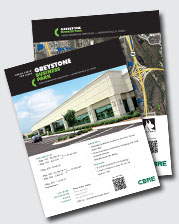 |
Welcome to my CBRE eNewsletter - an upbeat and informative source of commercial real estate industry trends.
Thank you for taking the time to read it. I value your support and feedback, so please let me know your thoughts! |
"Improve your bottom line and free up time with Traci Jenks!"
Traci Jenks, CCIM
Senior Associate
P: 904.633.2613
E: traci.jenks@cbre.com
What Is The Difference Between a Net and a Gross Lease?
Lately I’ve been asked to explain what is included in different types of leases. Below is a simple explanation:
TRIPLE-NET LEASE
With a triple-net lease the company renting the property is responsible for all the extra expenses associated with the property, including utilities, insurance and taxes. The landlord or property owner retains the full lease or rental payment and is not responsible for any other expenses associated with the property. A business with a triple-net lease is also typically responsible for the maintenance and any repairs the property will need during the term of the lease.
GROSS OR FULL SERVICE LEASE
The opposite of a triple net lease is a gross lease or full service. With a gross lease, the property renter writes a single check to the property owner and the owner is responsible for all of the expenses of the building. A gross lease is more common in an office building with a number of tenants. The building may be billed as a whole for utilities, taxes or insurance, making triple-net leases unworkable for the building owner and tenants.
NET LEASE
In a single-net or double-net lease, some of the property expenses will be paid by the building owner and some by the renter. Which expenses go to which side are determined on a property-by-property basis. Which expenses, such as taxes, maintenance or insurance, are the responsibility of the property renter are clearly spelled out in the lease contract. There is no standard formula or contract for single-net commercial leases.
If you would like more information on different types of leases or have a commercial real estate questions, please give me a call.
Some Heartbeat for Prime Office
-
Global office rents and real estate values increased modestly during Q2 2012, with the CBRE Global Office Rent and Global Office Capital Value Indices each rising by 0.3%.
-
Growth for all regions moderated in Q2; however, the U.S. market posted the strongest advancement in both rents and capital values, thanks to occupiers’ interest in Class A space in CBD locations.
-
Risk-averse investors continue to regard U.S. gateway markets as a comfort zone due to the perceived liquidity of trophy assets in markets such as New York, Chicago, San Francisco and Boston.
-
Overall, the performance of Asia Pacific’s Rent and Capital Value Indices has been noticeably muted, relative to the expansion witnessed in 2011. Regional variation
persists, though, and the Greater China and Pacific leasing and capital markets continue to fare well compared to other Asian markets such as Hong Kong, Singapore and Guangzhou.
-
Against the backdrop of the European Sovereign Debt Crisis, Europe is considerably weaker than both the Americas and Asia Pacific. The EMEA Rent Index declined slightly this quarter and its Capital Value Index declined for the third consecutive quarter. Markets with stronger economies in the Nordics and Germany have been performing best.
|




.jpg)
